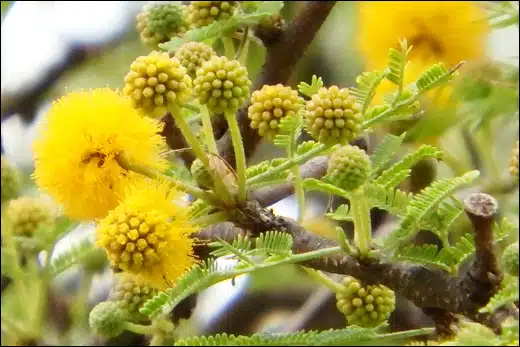Irimeda/ Sweet Acacia / Acacia farnesiana – Classification, Ayurvedic Properties & Dosage
Description
Irimeda (Acacia farnesiana) is an ethnomedicinal ayurvedic plant. It is widely used in traditional medicines to treat various oral and mouth problems, relaxing muscles and balances tridoshas. Also, In modern medicine, various properties of Irimeda are discovered such as Antidysenterica, Antiulcer, Antidiabetics, Anti-inflammatory, Antimicrobial, antioxidant etc. It is also used in biofuel production.

Synonyms
- Arimeda
- Vitkhadira
- Medoripu
- Pootimeda
- Kalaskandha
- Durgandha khair
- Huizache
Other Vernacular Names
- In Hindi – Irimeda, Arimeda
- In English – Sweet Acacia, The cassie flower, Needle bush
- In Malaysia – Bunga siam
- In Gujarati – Ganthalo khar
- In Bengali – Guyababla
- In Marathi – Gikikar
- In China – Ya zo shu pi
Taxonomical Classification
- Kingdom – Plantae
- Order – Fabales
- Family – Fabaceae
- Sub-Family – Mimosaceae
- Genus – Acacia
- Species – A.farnesiana
- Phylum – Spermatophyta
- Class – Dicotyledonae
Habitat
Irimeda is a tropical and subtropical species, found in places where the annual mean temperature range is 15°-30°C. It is a versatile, drought-hardy species, and grows on a wide range of well drained soils. It is a full sunlight shrub and it survives in the fires and regrows from its basal roots. It is indigenous to the Indian subcontinent as also in tropical Africa, Burma, Sri lanka.
Morphology
Irimeda is a tall, semi-green, native shrub and small tree that grows to a height 1-10 m, has feathery, finely divided leaves that are soft, mid-green. The slightly rough stems are rich chocolate brown and grey with long, sharp, uneven thorns. The small yellow puff-like flowers are strongly scented and appear in clusters in late winter. Perennial fruits have a shiny surface and contain seeds that are eaten by birds and other animals.
Chemical Composition
Irimeda has various phytochemicals due to these compounds, it shows a variety of pharmacognostic activities. These are:
| Part of the Plant | Phytonutrients | Properties |
| Leaves | Diterpenoids, aromadendrin, Lipids. Carotenoids, reducing and nonreducing sugars. | Anti-inflammatory, anti diabetics, demulcent. |
| Bark | Polyphenols: gallic acid, ellagic acid, digallic acid, Kaempferol, atomadendrin and naringenin and rutin. | Demulcent, antidysenteric, anti-inflammatory, stomatitis, ulcers, swollen gums, dental caries, skin diseases, anti tubercular, antiseptic. |
| Flowers | Volatile compounds: methyl salicylate, anisaldehyde, geraniol, benzaldehyde. | Muscle relaxant, anthelmintic, cardiac depressant, sedative, anti oxidant. |
| Seeds | Rich in amino acid: lysine, arginine,glycine, methionine. | Clotting agent, Anti inflammatory. |
Classical Categorisation
- Bhavaprakash nighantu: Vatadi varga
- Raja nighantu: Shalmalyadi varga
- Dhanvantari nighantu: Amradi varga
- Kaiyadeva nighantu: Aushdhi varga
- Susruta: Salasaradi varga
Ancient Verse
Shloka – 1
इरिमेदो विट्खदिरः कालस्कन्धोऽरिमेदकः |
इरिमेदः कषायोष्णो मुखदन्तगदाऽस्रजित् |
हन्ति कण्डूविषश्लेष्मकृमिकुष्ठविषव्रणान् ||
Reference – Bhavaprakash nighantu/ Vatadi varga/shloka 34
Interpretation of Shloka – This Shloka explains various synonyms of Irimeda such as vitkhadira, kalaskanda and arimedaka. It is described as hot potency (ushna), astringent (kashya). It is used in the treatment of mouth and teeth diseases (mukh dosha and daanta dosha), purifies blood and vitiates disorders such as acne, skin diseases and bleeding problems (rakt vikar). It also has properties to heal skin infections (kushtha), itching and pruritus (Kandu), removal of toxins (visha), worm infection of kapha origin (kaphaja krumina).
Shloka – 2
इरिमेदोऽरिमेदश्च गोधास्कन्धोऽरिमेदकः |
अहिमेदोऽहिमारश्च पूतिमेदोऽहिमेदकः ||४१||
अरिमेदः कषायोष्णस्तिक्तो भूतविनाशकः |
शोफातिसारकासघ्नो विषवीसर्पनाशनः ||४२||
Reference – Raj nighantu/ Salmalyadi varga/ Shloka 41-42
Interpretation of Shloka – In this shloka different synonyms of Arimeda such as Godhaskandha, Arimedaka, Ahimeda, Ahimara, Putimeda, and Ahimaraka. It is astringent (kashya), bitter (tikha), and saves from the effects of the evil spirits (bhoot nashak). It treats swelling (shopha), diarrhoea, cough, poisons and redness.
Ayurvedic Properties
- Rasa (Taste) – Kashya (astringent), tikta (bitter)
- Guna (Quality) – Laghu (light to digest), Ruksha (dry)
- Vipaka(after digestion) – Katu(pungent)
- Effect Of Tridosha – Kapha pitta shamak (reduces the vitiated kapha and pitta dosha)
Practical Uses
Irimeda is a valuable multipurpose species and all parts of the shrub can be used. Their uses are following:
- In conventional medicines, bark is used to treat cough and acts as an astringent.
- In past times, women who give birth used cassia flower as an emetic
- In the Philippines, it is used as an injection to treat leucorrhoea.
- For sore throat, the roots are chewed, and decoction of them is used to treat tuberculosis.
- To treat gonorrhoea and bladder ailments, the delicate leaves are crushed with little water and ten consumed.
- Blossoms are used as a stimulant and an antispasmodic.
- Green fruit is extremely astringent and used in a decoction to treat inflammation.
- Decoction of bark is used to treat diarrhoea.
- The paste of seeds is used to control bleeding from wounds.
- Bark and pods are useful for dyeing and tannins.
- The flowers have essential oils which are used in perfumes.
- The leaves and pods are palatable to livestock.
Part Used
Bark, flower, leaves, pods
Dosage
- Bark decoction : 40-50 ml
- Poder of flowers : 1-3 gm
Ayurvedic Products
- Arimedi Tailam
- Khadiradi Vati



